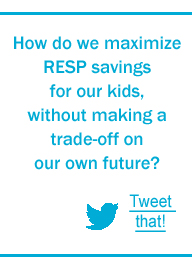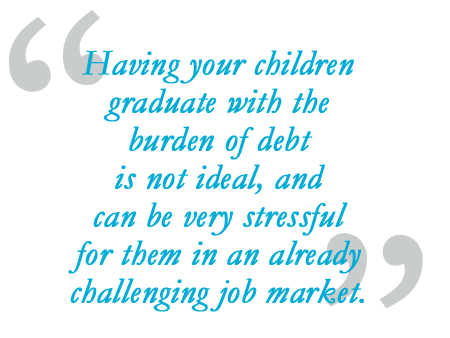By Bruce Q. Thompson, B.Admin, CFP®

From the moment our children are born we want the best for their future. Success is never guaranteed, but we hope to be able to offer them opportunities. And what better opportunity is there than education? So it seems like a straight forward assumption that we would contribute to a Registered Education Savings Plan (RESP).
But what about our own future? What about contributing to a Registered Retirement Savings Plan (RRSP)? Canadians are living longer, and the cost of living is always on the rise. If we don’t have a solid retirement plan, are we at risk of living in our well educated child’s basement? OK, that may be a tongue-in-cheek option, but the question of where to place our investment dollars is valid. What’s a parent to do?
The Fundamentals: What You Need to Know
RRSPs – Make an RRSP contribution and you get money back from the government in the form of a tax deduction. Depending on your tax bracket, a $1,000 contribution to your RRSP can reduce your tax bill by $400. You are taxed on the money when you withdraw it, but since most people have a lower tax bracket at retirement this is an excellent additional benefit.
RESPs – Open one and you’ll be eligible for the Canada Education Savings Grant (CESG) that will match at least 20% of your RESP contributions (up to $500) on an annual basis to a maximum lifetime grant of $7,200 per child (extra grants are available depending on your income). So, put in $500 the first year and the Government of Canada will give you another $100 in grant money to put towards your child’s education.
So let’s compare future scenarios: the time has come for your child to attend higher education and there isn’t enough money, versus you reaching retirement age without adequate funds. First, we’ll look at some reasons that it may be best to focus on our retirement needs and then we’ll look at some of the benefits for an RESP focus.
The Case for the RRSP
We need to be able take care of all our needs at retirement. Without a solid foundation of savings and investments, we risk having our standard of living decline. Canadians are living longer than ever, and outliving our money is the greatest risk of not having a solid retirement plan.
 We may not be able to actually retire. Without adequate savings and without wanting to increase our debt in our senior years, we may find ourselves needing to work to supplement our financial needs. But is that what we want for ourselves? Some people do, but many others have plans to pursue hobbies and travel, or spend time with their grandchildren. But even those willing to work may find that ill health, their own or their spouse’s, make this an impossible option. Our children on the other hand, have stamina and youth on their side if they need to work while going to school.
We may not be able to actually retire. Without adequate savings and without wanting to increase our debt in our senior years, we may find ourselves needing to work to supplement our financial needs. But is that what we want for ourselves? Some people do, but many others have plans to pursue hobbies and travel, or spend time with their grandchildren. But even those willing to work may find that ill health, their own or their spouse’s, make this an impossible option. Our children on the other hand, have stamina and youth on their side if they need to work while going to school.
We may not qualify for loans. If we don’t have enough money, we may be forced to remortgage our homes or take loans. But depending on our situation, will we even qualify? If our children are short of money for their education they can also seek financing. Our children, with precise needs for a short period of time, and years of earning potential ahead of them may have a better chance of securing the loans they need.
An RRSP has a better return on investment than an RESP. Another reason to choose an RRSP over an RESP is that the return on investment is higher. $2,500 in a RESP over 17 years (eligible for the maximum government grant) becomes slightly more than $50,000 by the time a child is headed to university. The same $2,500 depending on tax bracket, interest rates and reinvestment of any tax refund over the same 17 years, could compound to more than $280,000
The Case for the RESP
So what about our children? What are the risks to their financial future without the benefits of RESP savings?
Debt can make establishing a career harder. Having your children graduate with the burden of debt is not ideal, and can be very stressful for them in an already challenging job market. It may lead to jumping at the first opportunity for a paycheque instead of weighing options, and choosing a position that may mean less pay now but bigger professional opportunities down the road.
 Are summer employment and part time jobs even enough? Many students do not have the option of living at home while studying, and the cost of room and board sends the price of education well over $20,000 a year. That’s a steep bill on minimum wage. A large contribution from an RESP could easily become the difference between your child attending the school of their choice instead of settling for an academic institution closer to home.
Are summer employment and part time jobs even enough? Many students do not have the option of living at home while studying, and the cost of room and board sends the price of education well over $20,000 a year. That’s a steep bill on minimum wage. A large contribution from an RESP could easily become the difference between your child attending the school of their choice instead of settling for an academic institution closer to home.
A Few Questions to Ask Yourself
So how do you weigh your situation? The most important thing is clarity. If we value education we may want to maximize RESP savings for our children, but we have to be certain we aren’t making a risky trade-off on our own future.
Depending on how old we are when our children are born, we may be able to take advantage of that “free” money (Canada Education Savings Grant) and still have many years to focus on our retirement savings.
In order to help you make the right decision based upon your unique circumstances, ask yourself the following questions:
- How much do you have available for savings? If you don’t know, download our Spending and Savings plan or call a Money Coach.
- Are you on track for your own retirement? It’s important to help the kids but make sure you’re taking care of yourself! Be sure you know your retirement numbers. Use our Financial Freedom calculator or call a Money Coach.
- Your personal philosophy. How important is it to you to fund your kids’ education? For some, their desire to contribute to their kids’ schooling trumps everything else.
- What’s your tax bracket? The higher your tax bracket, the larger the benefit from investing in an RRSP. If your taxable income is over $145K your RRSP contribution would provide a tax refund in the 45% range (depending on your province). A $10K contribution would generate a refund of $4.5K.
With a clear look at your current finances and a plan that considers the big picture, there is probably a nice compromise that can support your retirement needs and your hopes for your children’s future.
